Principles of Clotting Screen Tests
VerifiedAdded on 2023/04/21
|8
|1421
|272
AI Summary
This document discusses the principles of clotting screen tests, specifically Prothrombine Time (PT) and Activated Partial Thromboplastin Time (APTT). These tests are used to assess and monitor bleeding risks and conditions. The document explains the process of blood coagulation and how these tests measure the clotting activity of different pathways. It also discusses the importance of quality control testing and the interpretation of patient sample results.
Contribute Materials
Your contribution can guide someone’s learning journey. Share your
documents today.
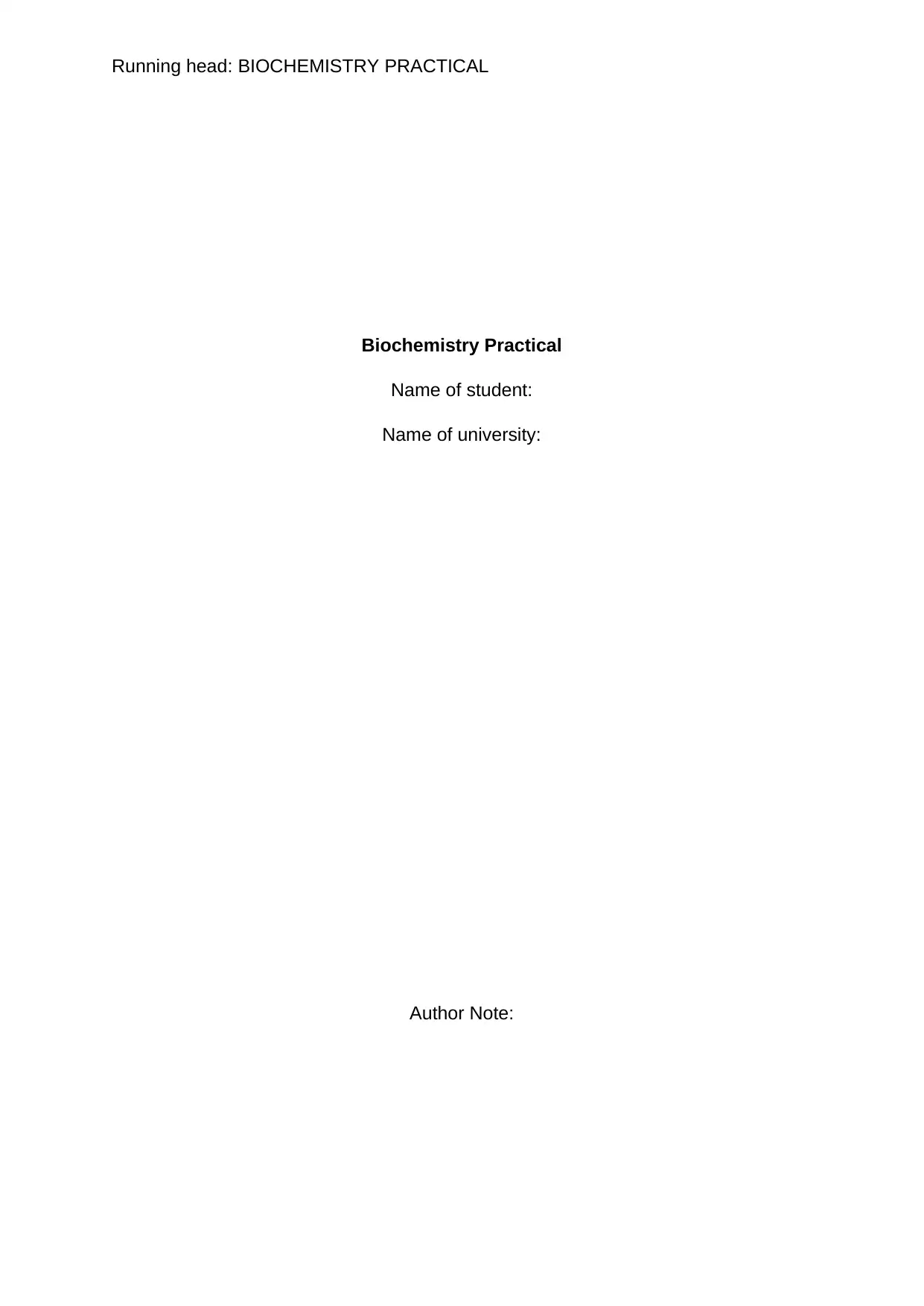
Running head: BIOCHEMISTRY PRACTICAL
Biochemistry Practical
Name of student:
Name of university:
Author Note:
Biochemistry Practical
Name of student:
Name of university:
Author Note:
Secure Best Marks with AI Grader
Need help grading? Try our AI Grader for instant feedback on your assignments.
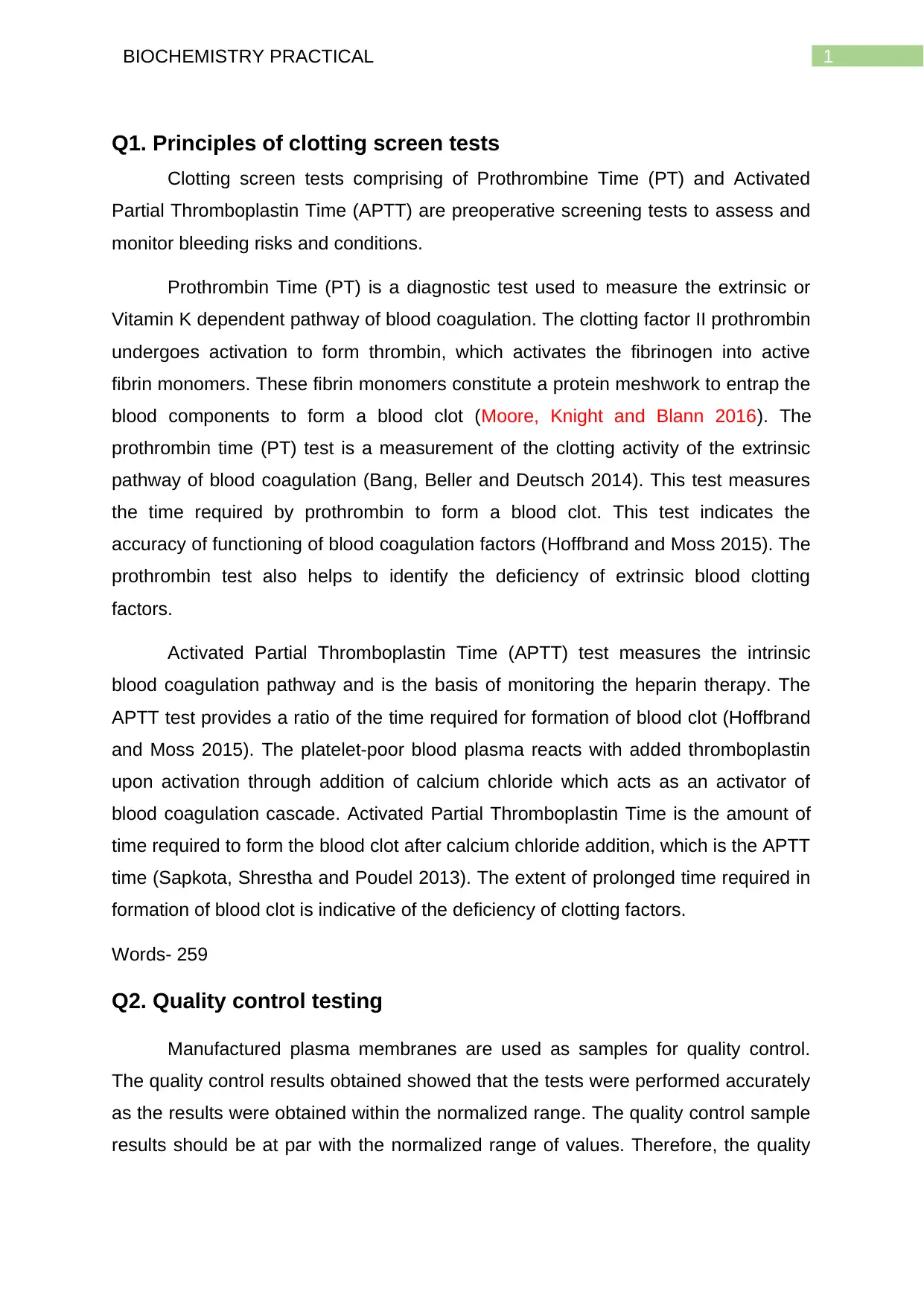
1BIOCHEMISTRY PRACTICAL
Q1. Principles of clotting screen tests
Clotting screen tests comprising of Prothrombine Time (PT) and Activated
Partial Thromboplastin Time (APTT) are preoperative screening tests to assess and
monitor bleeding risks and conditions.
Prothrombin Time (PT) is a diagnostic test used to measure the extrinsic or
Vitamin K dependent pathway of blood coagulation. The clotting factor II prothrombin
undergoes activation to form thrombin, which activates the fibrinogen into active
fibrin monomers. These fibrin monomers constitute a protein meshwork to entrap the
blood components to form a blood clot (Moore, Knight and Blann 2016). The
prothrombin time (PT) test is a measurement of the clotting activity of the extrinsic
pathway of blood coagulation (Bang, Beller and Deutsch 2014). This test measures
the time required by prothrombin to form a blood clot. This test indicates the
accuracy of functioning of blood coagulation factors (Hoffbrand and Moss 2015). The
prothrombin test also helps to identify the deficiency of extrinsic blood clotting
factors.
Activated Partial Thromboplastin Time (APTT) test measures the intrinsic
blood coagulation pathway and is the basis of monitoring the heparin therapy. The
APTT test provides a ratio of the time required for formation of blood clot (Hoffbrand
and Moss 2015). The platelet-poor blood plasma reacts with added thromboplastin
upon activation through addition of calcium chloride which acts as an activator of
blood coagulation cascade. Activated Partial Thromboplastin Time is the amount of
time required to form the blood clot after calcium chloride addition, which is the APTT
time (Sapkota, Shrestha and Poudel 2013). The extent of prolonged time required in
formation of blood clot is indicative of the deficiency of clotting factors.
Words- 259
Q2. Quality control testing
Manufactured plasma membranes are used as samples for quality control.
The quality control results obtained showed that the tests were performed accurately
as the results were obtained within the normalized range. The quality control sample
results should be at par with the normalized range of values. Therefore, the quality
Q1. Principles of clotting screen tests
Clotting screen tests comprising of Prothrombine Time (PT) and Activated
Partial Thromboplastin Time (APTT) are preoperative screening tests to assess and
monitor bleeding risks and conditions.
Prothrombin Time (PT) is a diagnostic test used to measure the extrinsic or
Vitamin K dependent pathway of blood coagulation. The clotting factor II prothrombin
undergoes activation to form thrombin, which activates the fibrinogen into active
fibrin monomers. These fibrin monomers constitute a protein meshwork to entrap the
blood components to form a blood clot (Moore, Knight and Blann 2016). The
prothrombin time (PT) test is a measurement of the clotting activity of the extrinsic
pathway of blood coagulation (Bang, Beller and Deutsch 2014). This test measures
the time required by prothrombin to form a blood clot. This test indicates the
accuracy of functioning of blood coagulation factors (Hoffbrand and Moss 2015). The
prothrombin test also helps to identify the deficiency of extrinsic blood clotting
factors.
Activated Partial Thromboplastin Time (APTT) test measures the intrinsic
blood coagulation pathway and is the basis of monitoring the heparin therapy. The
APTT test provides a ratio of the time required for formation of blood clot (Hoffbrand
and Moss 2015). The platelet-poor blood plasma reacts with added thromboplastin
upon activation through addition of calcium chloride which acts as an activator of
blood coagulation cascade. Activated Partial Thromboplastin Time is the amount of
time required to form the blood clot after calcium chloride addition, which is the APTT
time (Sapkota, Shrestha and Poudel 2013). The extent of prolonged time required in
formation of blood clot is indicative of the deficiency of clotting factors.
Words- 259
Q2. Quality control testing
Manufactured plasma membranes are used as samples for quality control.
The quality control results obtained showed that the tests were performed accurately
as the results were obtained within the normalized range. The quality control sample
results should be at par with the normalized range of values. Therefore, the quality
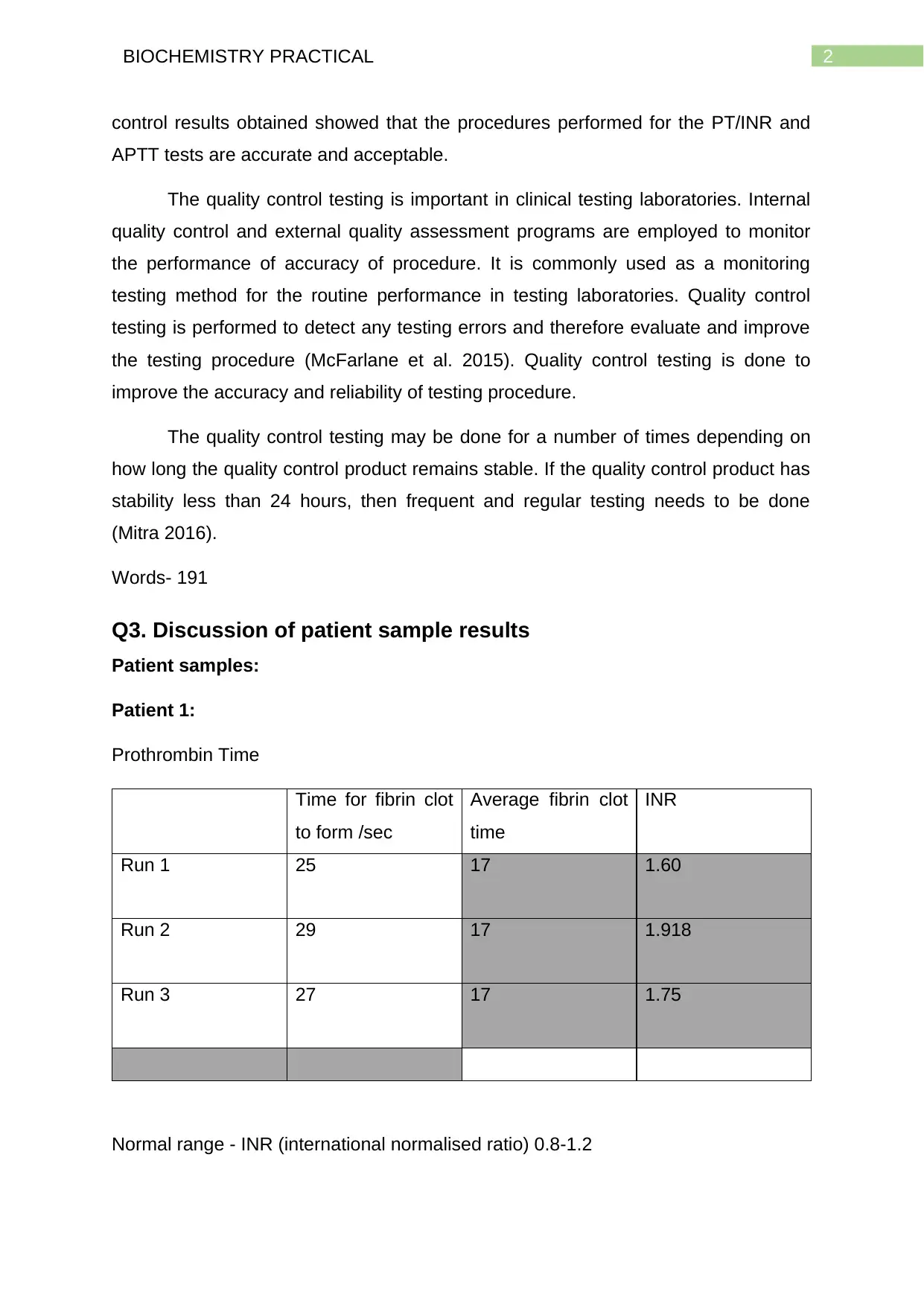
2BIOCHEMISTRY PRACTICAL
control results obtained showed that the procedures performed for the PT/INR and
APTT tests are accurate and acceptable.
The quality control testing is important in clinical testing laboratories. Internal
quality control and external quality assessment programs are employed to monitor
the performance of accuracy of procedure. It is commonly used as a monitoring
testing method for the routine performance in testing laboratories. Quality control
testing is performed to detect any testing errors and therefore evaluate and improve
the testing procedure (McFarlane et al. 2015). Quality control testing is done to
improve the accuracy and reliability of testing procedure.
The quality control testing may be done for a number of times depending on
how long the quality control product remains stable. If the quality control product has
stability less than 24 hours, then frequent and regular testing needs to be done
(Mitra 2016).
Words- 191
Q3. Discussion of patient sample results
Patient samples:
Patient 1:
Prothrombin Time
Time for fibrin clot
to form /sec
Average fibrin clot
time
INR
Run 1 25 17 1.60
Run 2 29 17 1.918
Run 3 27 17 1.75
Normal range - INR (international normalised ratio) 0.8-1.2
control results obtained showed that the procedures performed for the PT/INR and
APTT tests are accurate and acceptable.
The quality control testing is important in clinical testing laboratories. Internal
quality control and external quality assessment programs are employed to monitor
the performance of accuracy of procedure. It is commonly used as a monitoring
testing method for the routine performance in testing laboratories. Quality control
testing is performed to detect any testing errors and therefore evaluate and improve
the testing procedure (McFarlane et al. 2015). Quality control testing is done to
improve the accuracy and reliability of testing procedure.
The quality control testing may be done for a number of times depending on
how long the quality control product remains stable. If the quality control product has
stability less than 24 hours, then frequent and regular testing needs to be done
(Mitra 2016).
Words- 191
Q3. Discussion of patient sample results
Patient samples:
Patient 1:
Prothrombin Time
Time for fibrin clot
to form /sec
Average fibrin clot
time
INR
Run 1 25 17 1.60
Run 2 29 17 1.918
Run 3 27 17 1.75
Normal range - INR (international normalised ratio) 0.8-1.2
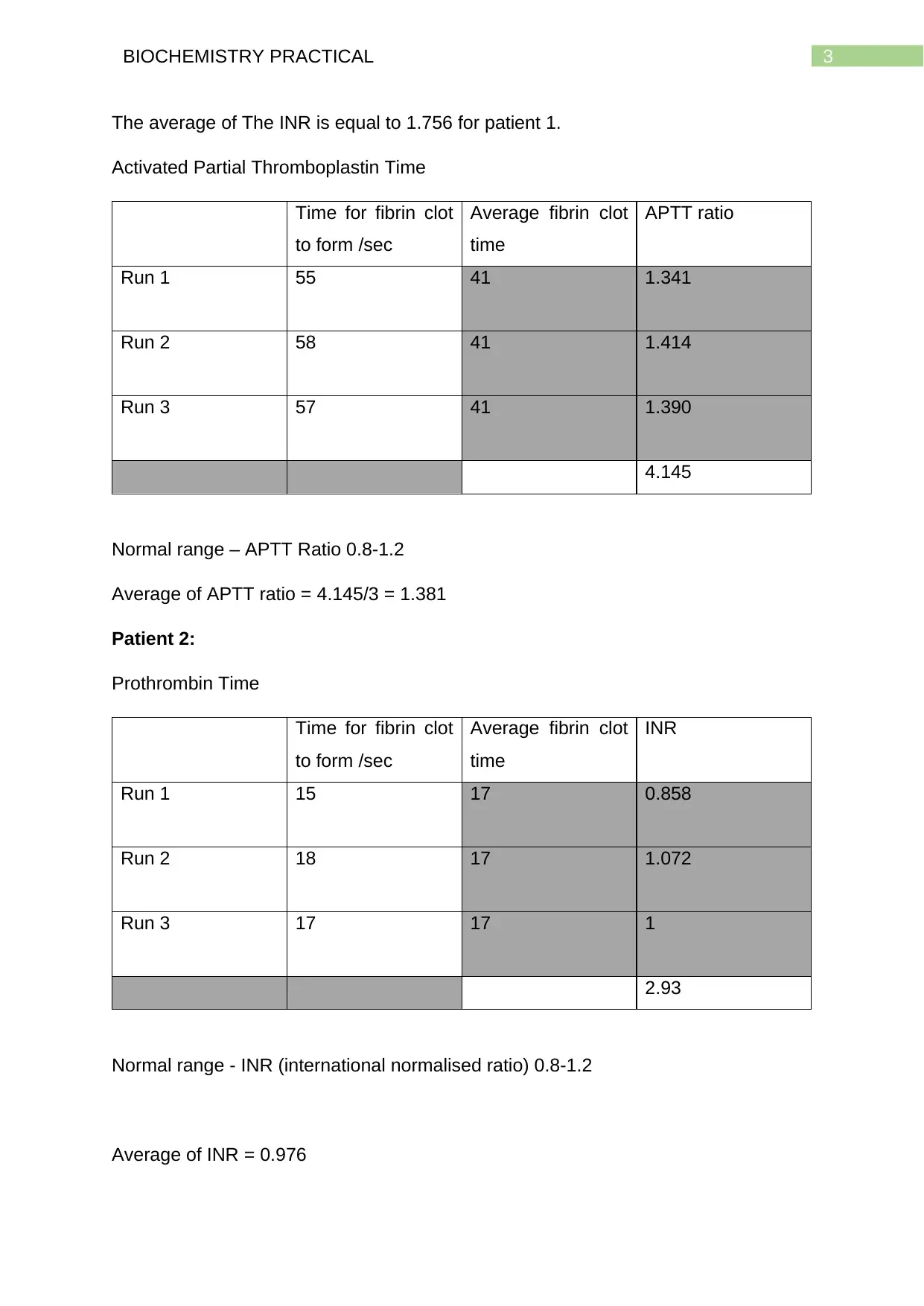
3BIOCHEMISTRY PRACTICAL
The average of The INR is equal to 1.756 for patient 1.
Activated Partial Thromboplastin Time
Time for fibrin clot
to form /sec
Average fibrin clot
time
APTT ratio
Run 1 55 41 1.341
Run 2 58 41 1.414
Run 3 57 41 1.390
4.145
Normal range – APTT Ratio 0.8-1.2
Average of APTT ratio = 4.145/3 = 1.381
Patient 2:
Prothrombin Time
Time for fibrin clot
to form /sec
Average fibrin clot
time
INR
Run 1 15 17 0.858
Run 2 18 17 1.072
Run 3 17 17 1
2.93
Normal range - INR (international normalised ratio) 0.8-1.2
Average of INR = 0.976
The average of The INR is equal to 1.756 for patient 1.
Activated Partial Thromboplastin Time
Time for fibrin clot
to form /sec
Average fibrin clot
time
APTT ratio
Run 1 55 41 1.341
Run 2 58 41 1.414
Run 3 57 41 1.390
4.145
Normal range – APTT Ratio 0.8-1.2
Average of APTT ratio = 4.145/3 = 1.381
Patient 2:
Prothrombin Time
Time for fibrin clot
to form /sec
Average fibrin clot
time
INR
Run 1 15 17 0.858
Run 2 18 17 1.072
Run 3 17 17 1
2.93
Normal range - INR (international normalised ratio) 0.8-1.2
Average of INR = 0.976
Secure Best Marks with AI Grader
Need help grading? Try our AI Grader for instant feedback on your assignments.
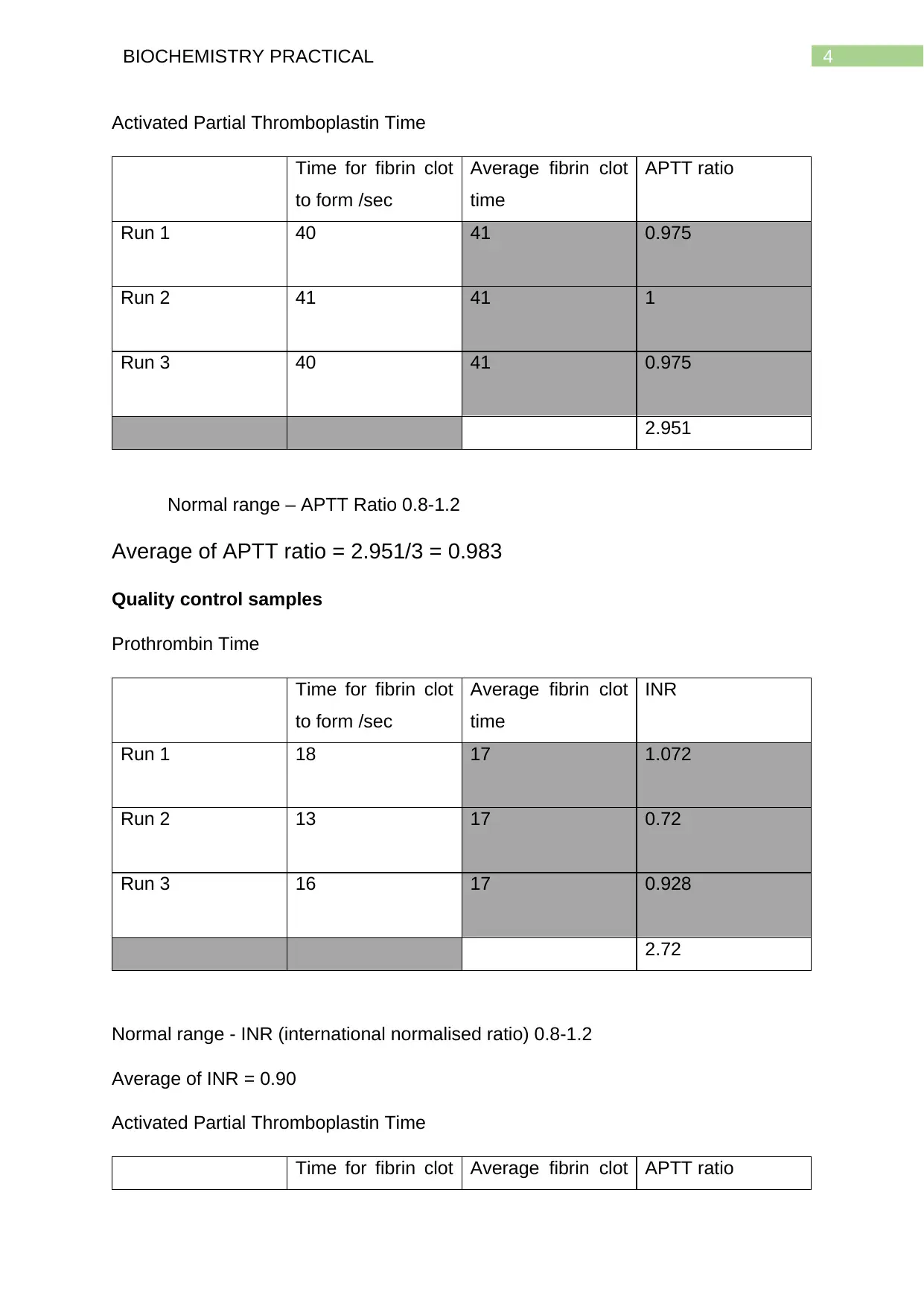
4BIOCHEMISTRY PRACTICAL
Activated Partial Thromboplastin Time
Time for fibrin clot
to form /sec
Average fibrin clot
time
APTT ratio
Run 1 40 41 0.975
Run 2 41 41 1
Run 3 40 41 0.975
2.951
Normal range – APTT Ratio 0.8-1.2
Average of APTT ratio = 2.951/3 = 0.983
Quality control samples
Prothrombin Time
Time for fibrin clot
to form /sec
Average fibrin clot
time
INR
Run 1 18 17 1.072
Run 2 13 17 0.72
Run 3 16 17 0.928
2.72
Normal range - INR (international normalised ratio) 0.8-1.2
Average of INR = 0.90
Activated Partial Thromboplastin Time
Time for fibrin clot Average fibrin clot APTT ratio
Activated Partial Thromboplastin Time
Time for fibrin clot
to form /sec
Average fibrin clot
time
APTT ratio
Run 1 40 41 0.975
Run 2 41 41 1
Run 3 40 41 0.975
2.951
Normal range – APTT Ratio 0.8-1.2
Average of APTT ratio = 2.951/3 = 0.983
Quality control samples
Prothrombin Time
Time for fibrin clot
to form /sec
Average fibrin clot
time
INR
Run 1 18 17 1.072
Run 2 13 17 0.72
Run 3 16 17 0.928
2.72
Normal range - INR (international normalised ratio) 0.8-1.2
Average of INR = 0.90
Activated Partial Thromboplastin Time
Time for fibrin clot Average fibrin clot APTT ratio
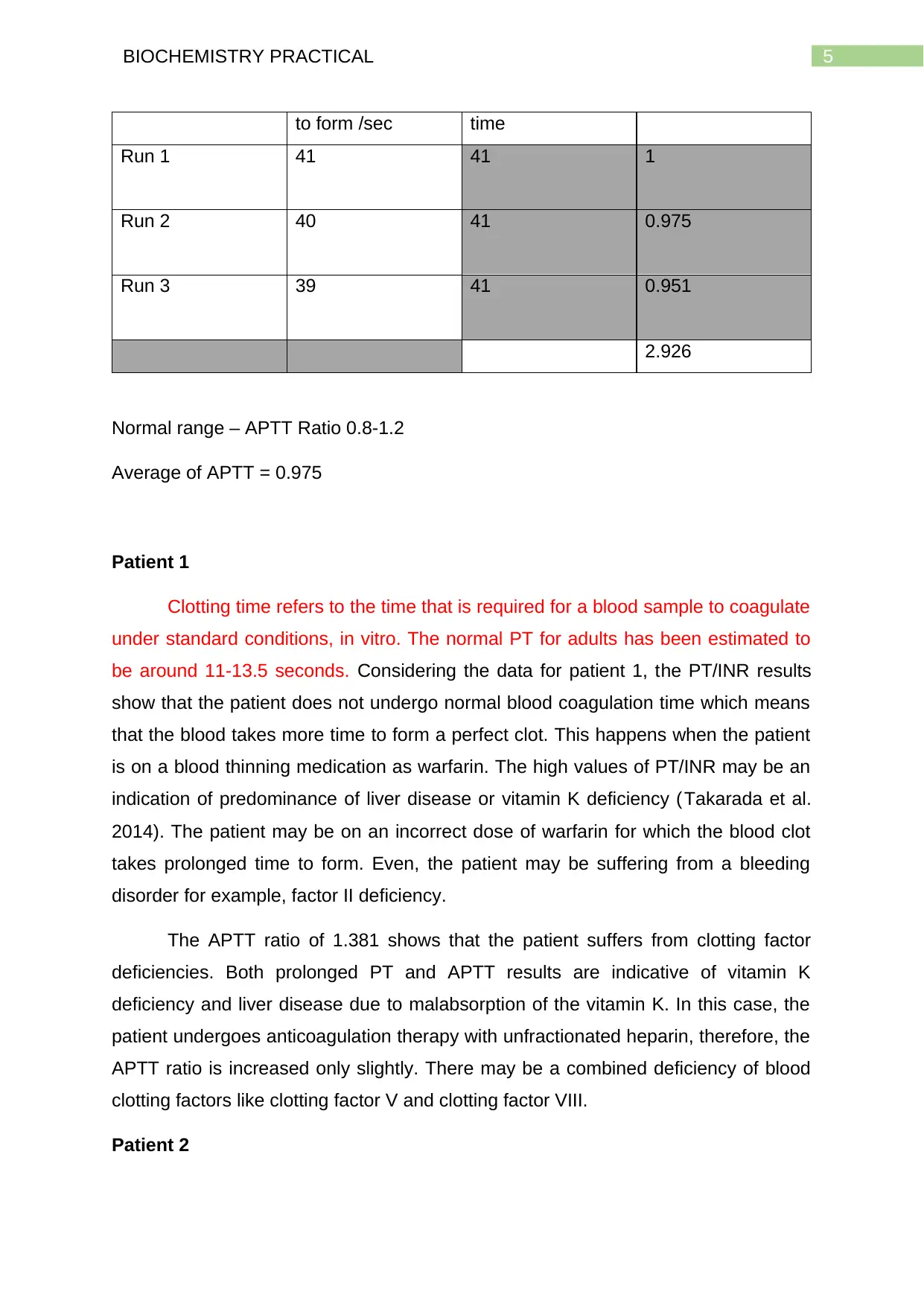
5BIOCHEMISTRY PRACTICAL
to form /sec time
Run 1 41 41 1
Run 2 40 41 0.975
Run 3 39 41 0.951
2.926
Normal range – APTT Ratio 0.8-1.2
Average of APTT = 0.975
Patient 1
Clotting time refers to the time that is required for a blood sample to coagulate
under standard conditions, in vitro. The normal PT for adults has been estimated to
be around 11-13.5 seconds. Considering the data for patient 1, the PT/INR results
show that the patient does not undergo normal blood coagulation time which means
that the blood takes more time to form a perfect clot. This happens when the patient
is on a blood thinning medication as warfarin. The high values of PT/INR may be an
indication of predominance of liver disease or vitamin K deficiency (Takarada et al.
2014). The patient may be on an incorrect dose of warfarin for which the blood clot
takes prolonged time to form. Even, the patient may be suffering from a bleeding
disorder for example, factor II deficiency.
The APTT ratio of 1.381 shows that the patient suffers from clotting factor
deficiencies. Both prolonged PT and APTT results are indicative of vitamin K
deficiency and liver disease due to malabsorption of the vitamin K. In this case, the
patient undergoes anticoagulation therapy with unfractionated heparin, therefore, the
APTT ratio is increased only slightly. There may be a combined deficiency of blood
clotting factors like clotting factor V and clotting factor VIII.
Patient 2
to form /sec time
Run 1 41 41 1
Run 2 40 41 0.975
Run 3 39 41 0.951
2.926
Normal range – APTT Ratio 0.8-1.2
Average of APTT = 0.975
Patient 1
Clotting time refers to the time that is required for a blood sample to coagulate
under standard conditions, in vitro. The normal PT for adults has been estimated to
be around 11-13.5 seconds. Considering the data for patient 1, the PT/INR results
show that the patient does not undergo normal blood coagulation time which means
that the blood takes more time to form a perfect clot. This happens when the patient
is on a blood thinning medication as warfarin. The high values of PT/INR may be an
indication of predominance of liver disease or vitamin K deficiency (Takarada et al.
2014). The patient may be on an incorrect dose of warfarin for which the blood clot
takes prolonged time to form. Even, the patient may be suffering from a bleeding
disorder for example, factor II deficiency.
The APTT ratio of 1.381 shows that the patient suffers from clotting factor
deficiencies. Both prolonged PT and APTT results are indicative of vitamin K
deficiency and liver disease due to malabsorption of the vitamin K. In this case, the
patient undergoes anticoagulation therapy with unfractionated heparin, therefore, the
APTT ratio is increased only slightly. There may be a combined deficiency of blood
clotting factors like clotting factor V and clotting factor VIII.
Patient 2
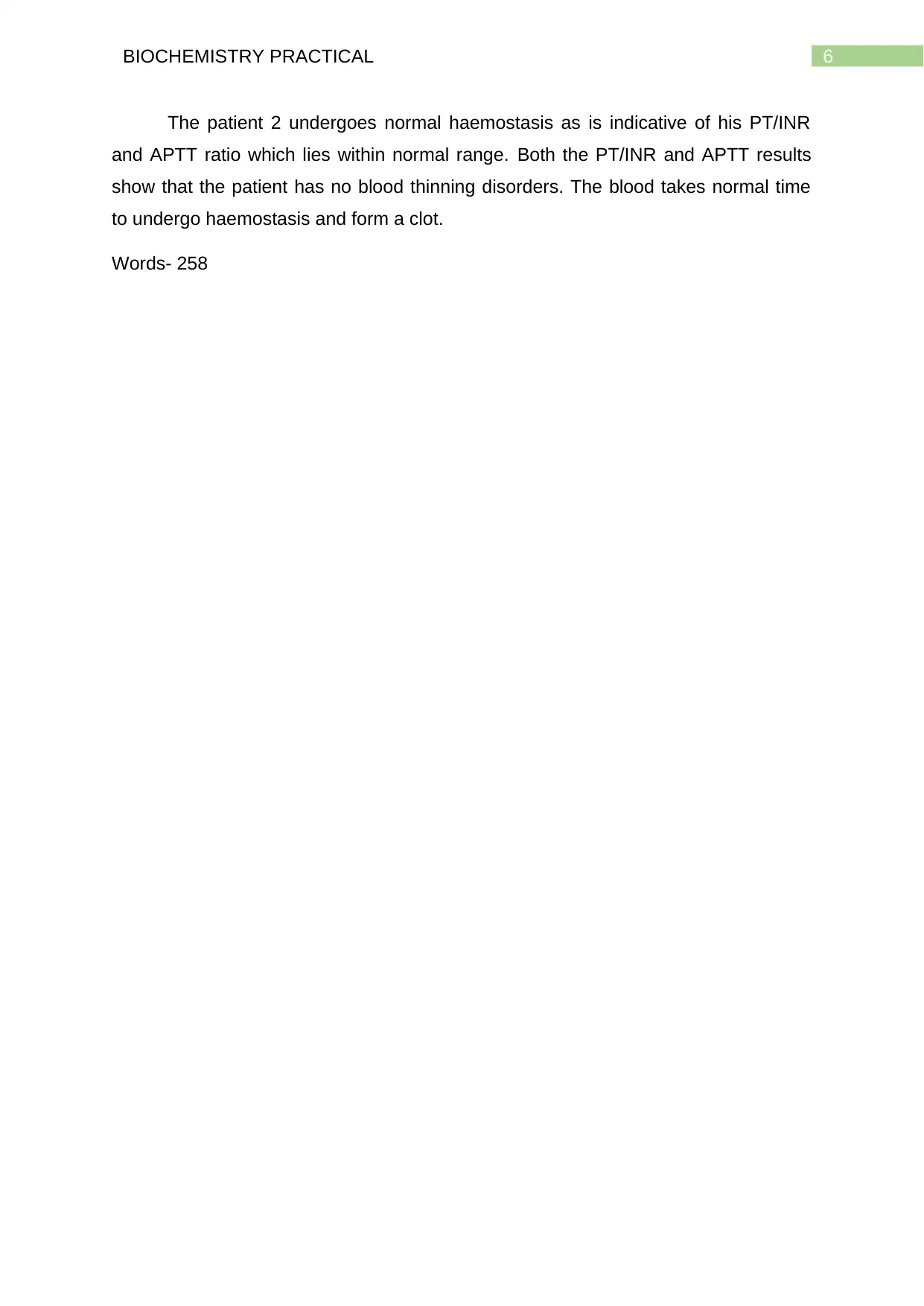
6BIOCHEMISTRY PRACTICAL
The patient 2 undergoes normal haemostasis as is indicative of his PT/INR
and APTT ratio which lies within normal range. Both the PT/INR and APTT results
show that the patient has no blood thinning disorders. The blood takes normal time
to undergo haemostasis and form a clot.
Words- 258
The patient 2 undergoes normal haemostasis as is indicative of his PT/INR
and APTT ratio which lies within normal range. Both the PT/INR and APTT results
show that the patient has no blood thinning disorders. The blood takes normal time
to undergo haemostasis and form a clot.
Words- 258
Paraphrase This Document
Need a fresh take? Get an instant paraphrase of this document with our AI Paraphraser
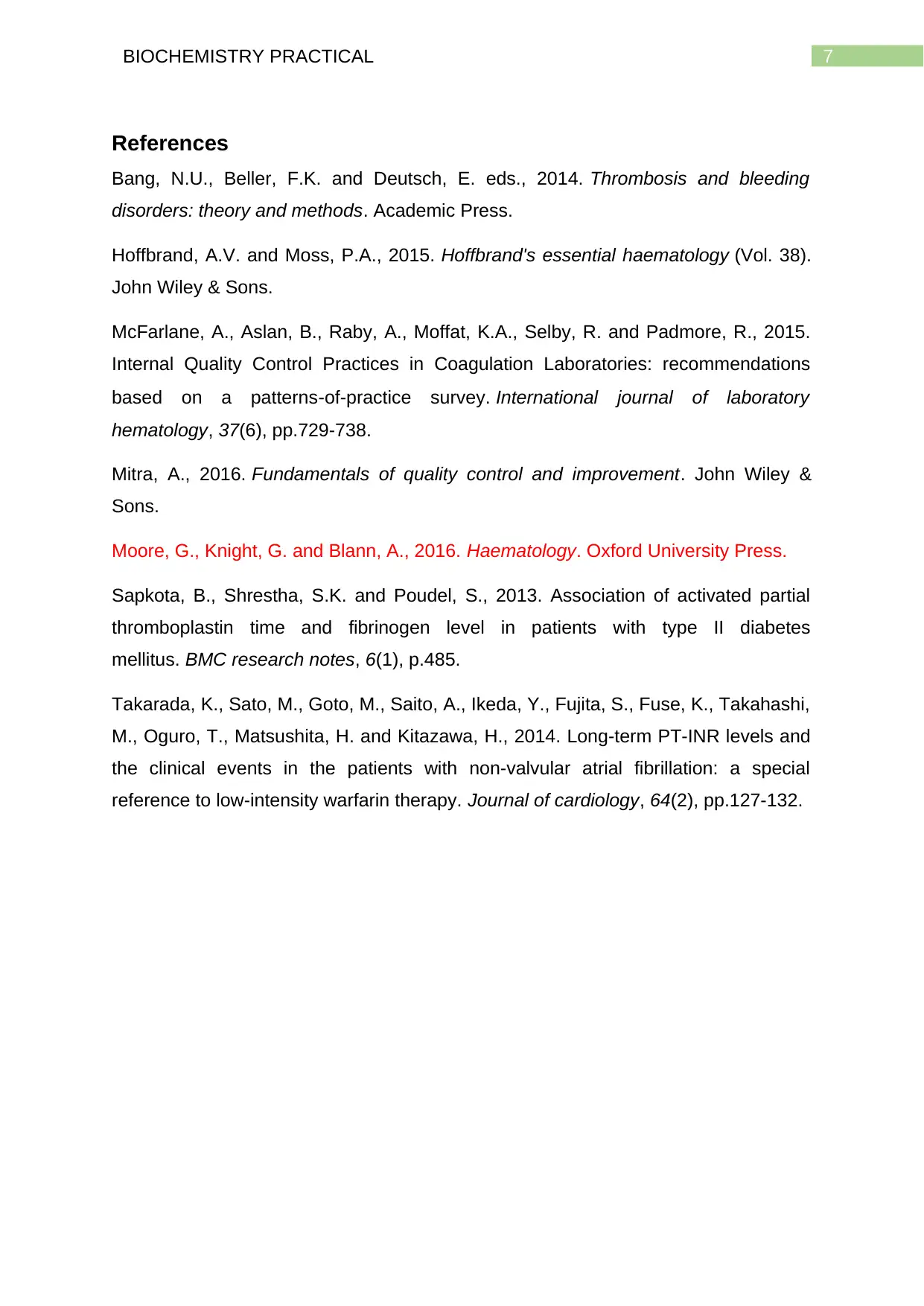
7BIOCHEMISTRY PRACTICAL
References
Bang, N.U., Beller, F.K. and Deutsch, E. eds., 2014. Thrombosis and bleeding
disorders: theory and methods. Academic Press.
Hoffbrand, A.V. and Moss, P.A., 2015. Hoffbrand's essential haematology (Vol. 38).
John Wiley & Sons.
McFarlane, A., Aslan, B., Raby, A., Moffat, K.A., Selby, R. and Padmore, R., 2015.
Internal Quality Control Practices in Coagulation Laboratories: recommendations
based on a patterns‐of‐practice survey. International journal of laboratory
hematology, 37(6), pp.729-738.
Mitra, A., 2016. Fundamentals of quality control and improvement. John Wiley &
Sons.
Moore, G., Knight, G. and Blann, A., 2016. Haematology. Oxford University Press.
Sapkota, B., Shrestha, S.K. and Poudel, S., 2013. Association of activated partial
thromboplastin time and fibrinogen level in patients with type II diabetes
mellitus. BMC research notes, 6(1), p.485.
Takarada, K., Sato, M., Goto, M., Saito, A., Ikeda, Y., Fujita, S., Fuse, K., Takahashi,
M., Oguro, T., Matsushita, H. and Kitazawa, H., 2014. Long-term PT-INR levels and
the clinical events in the patients with non-valvular atrial fibrillation: a special
reference to low-intensity warfarin therapy. Journal of cardiology, 64(2), pp.127-132.
References
Bang, N.U., Beller, F.K. and Deutsch, E. eds., 2014. Thrombosis and bleeding
disorders: theory and methods. Academic Press.
Hoffbrand, A.V. and Moss, P.A., 2015. Hoffbrand's essential haematology (Vol. 38).
John Wiley & Sons.
McFarlane, A., Aslan, B., Raby, A., Moffat, K.A., Selby, R. and Padmore, R., 2015.
Internal Quality Control Practices in Coagulation Laboratories: recommendations
based on a patterns‐of‐practice survey. International journal of laboratory
hematology, 37(6), pp.729-738.
Mitra, A., 2016. Fundamentals of quality control and improvement. John Wiley &
Sons.
Moore, G., Knight, G. and Blann, A., 2016. Haematology. Oxford University Press.
Sapkota, B., Shrestha, S.K. and Poudel, S., 2013. Association of activated partial
thromboplastin time and fibrinogen level in patients with type II diabetes
mellitus. BMC research notes, 6(1), p.485.
Takarada, K., Sato, M., Goto, M., Saito, A., Ikeda, Y., Fujita, S., Fuse, K., Takahashi,
M., Oguro, T., Matsushita, H. and Kitazawa, H., 2014. Long-term PT-INR levels and
the clinical events in the patients with non-valvular atrial fibrillation: a special
reference to low-intensity warfarin therapy. Journal of cardiology, 64(2), pp.127-132.
1 out of 8
Related Documents
Your All-in-One AI-Powered Toolkit for Academic Success.
+13062052269
info@desklib.com
Available 24*7 on WhatsApp / Email
![[object Object]](/_next/static/media/star-bottom.7253800d.svg)
Unlock your academic potential
© 2024 | Zucol Services PVT LTD | All rights reserved.
